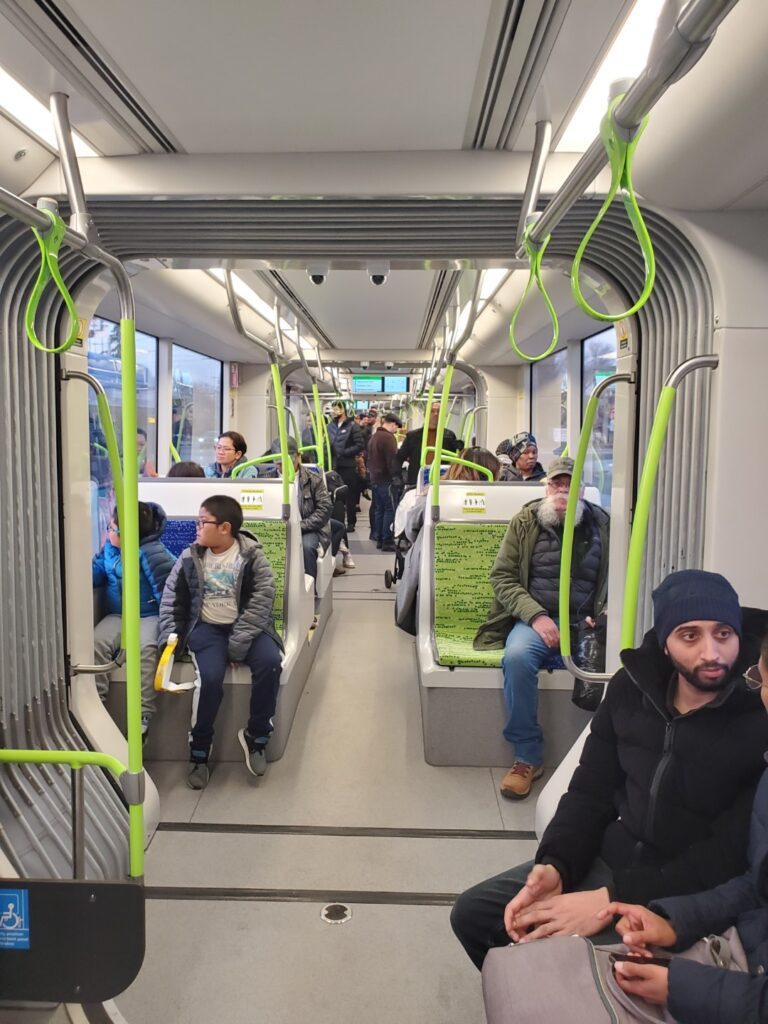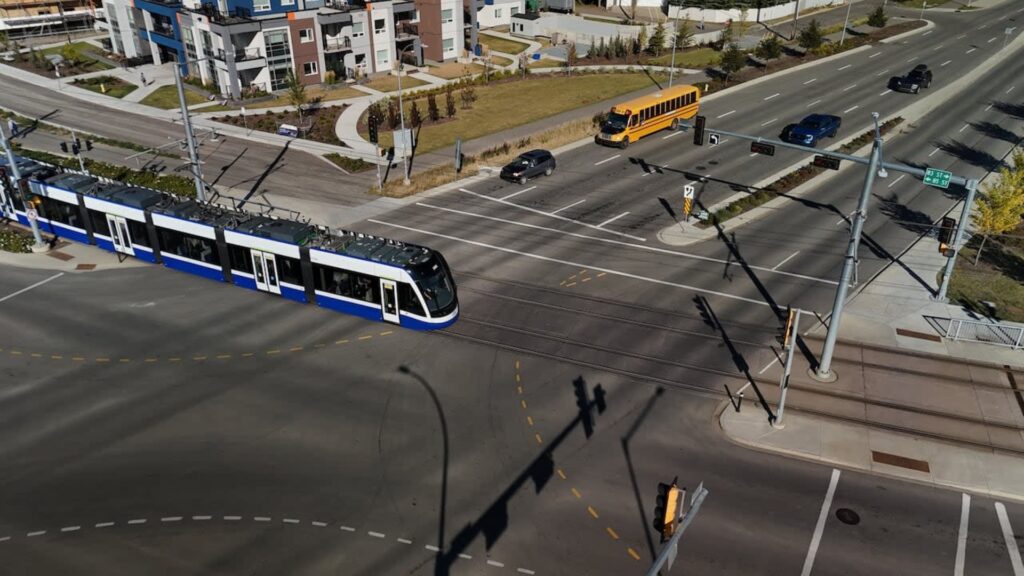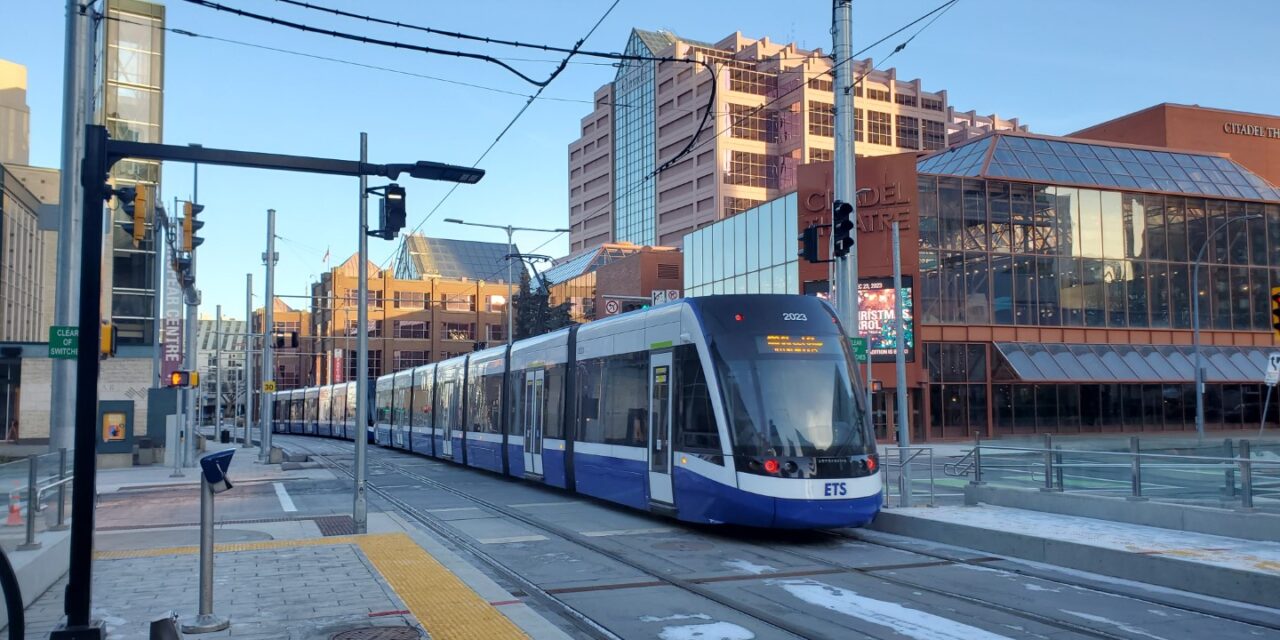Photo: Matthew Boonstra (Wiki)
Review by Hannah Dean
Guest writer from the University of Alberta’s Creative Non-Fiction writing program
I first rode along the Edmonton LRT Valley Line a few days after the opening of its first phase on November 4, 2023—nearly three years after its expected completion. It was distinctly cleaner than the city’s other two Light Rapid Transit (LRT) lines, though that can be chalked up to its recent debut—the city hasn’t had time to get all its grime on it. Still, I’d argue that a ride down the Valley Line is a lot more pleasing than riding on the Capital or Metro Line.
The finalization of the Valley Line’s second phase is estimated to be coming sometime in 2028—pretty optimistic considering the initial delay of nearly three years. In its first phase, it covers a line from downtown, 102nd Street, all the way to the Mill Woods Town Centre—connecting suburban southside Edmonton to the inner city. The future plans of the second phase hope to reach into the west, joining the downtown to Lewis Farms, with sixteen stops in between—including the West Edmonton Mall.
All three lines run daily from 5:00 a.m. to 1:00 a.m. On weekdays, the trains arrive every ten minutes, and on weekends, it’s fifteen minutes. However, peak times—6-9 a.m. and 2-6 p.m. on weekdays—have the trains running every fifteen minutes.
The Valley Line is a low-floor LRT. This means the majority of its equipment—like motors—is embedded in the train’s roof (unlike high-floors, with their motors in the bottom), so its platforms do not need to be elevated, allowing for street-level boarding. As such, the Valley Line can squeeze within neighbourhoods, contrary to the high-floor Metro and Capital Lines, which require more elaborate platforms. This brings the LRT closer to its commuters, and the street-level boarding also allows for greater accessibility for wheelchair users, which is always a plus.
The low-floor design also means quicker acceleration, allowing the Valley Line to travel faster, at eighty km/h—though due to the frequent stops, it travels at around sixty km/h. It’s still quicker than the Metro and Capital Lines, which travel at fifty km/h. While the combined Metro and Capital Lines cover twenty-five kilometres with eighteen stops, the Valley Line—in the completion of the second phase—will cover twenty-seven kilometres with twenty-eight stops. Currently, it covers only fourteen kilometres with twelve stops.
In its entirety, the Valley Line will be a more practical and faster choice of transit. It’s wedged right into neighbourhoods—practically sitting on people’s doorsteps—and is easily accessible.
Alex Antoneshyn from CTV News echoes these benefits, as she wrote three days after the Valley Line’s opening that “the majority of feedback was positive” and that the newest edition is “convenient, safe, comfortable.”
Two years after its debut, I argue that those sentiments tentatively hold true.

I’ve used the Valley Line regularly for over a year for various reasons, from school to work to going to the movies. The convenience only went as far as where you lived. The low-floor platforms mean that many stations lack parkades, and those that do have parking charges, costing more than the actual LRT ride itself. The paid parking at Mill Woods Town Centre will cost four dollars an hour, while the actual train ride—paid with an ARC card—would cost only $3.75, or free if you’re under twelve.
Though paid parking is an issue throughout the city, the lack of any parkades makes the Valley Line inconvenient unless I’m living within one of the neighbourhoods the line inhabits. The only other parkade on the Valley Line is the Davies Transit Station on 75th and Wagner Road, which is free. The station also sits right in the heart of an industrial area and next to W.P. Wagner High School, so good luck finding any parking during working hours.
Aside from the low-floor design, the streetcars on the Valley Line are distinct from their precursors in another way: seating. While the Metro and Capital Lines have narrower seats, they have more. I estimate that for every one seat the Valley Line has, the Metro and Capital have two. The Valley Line seats are often raised up on a platform, pushed together, and facing inwards, lessening the amount of legroom available—though there is plenty of aisle space.
The interior of the Valley Line is nicer than the other lines. Wide-open windows, sleek and smooth curves, and bright blues and greens give the interior a modern feeling. I feel rather claustrophobic on the Metro and Capital Lines, especially when they’re underground. But with the Valley Line—sitting up on street level—the seat-to-ceiling windows let in sunlight and give my eyes something to look at aside from my phone.
However, sitting at street level does invite a rather drastic encounter between the LRT and motor vehicles. During its first year, the Valley Line had twenty-three collisions, whereas both the Metro and Capital Lines average three per year. Many of these collisions involve illegal right turns, but I would argue that the lack of gates for crossings is simply negligence on the city’s part.

Moreover, to transfer from the Valley Line to the Metro or Capital Line, I have to go downtown to Churchill. As a young woman, I need to avoid non-daylight hours and go with friends for my own safety. That station is typically filthy, with a man regularly shouting hateful rhetoric on a speakerphone across the street. However, the other stations on the Valley Line are cleaner and feel safer than the other lines because they aren’t enclosed and sit on sidewalks in public places.
Unlike the Metro and Capital Lines, police routinely march up and down the seating aisle in some sort of hurry. While I, a Muslim, may feel uncomfortable with the police’s surveillance—especially as I’ve been followed off the train and questioned a few times too many—others would find their presence reassuring, I’m sure.
Personally, I don’t find any public transit to be enjoyable, simply due to the nature of transiting—it’s just a mode of getting from one place to another and turning my brain off. But the Valley Line is one of the better options of Edmonton’s pitiful choices of public transit. It’s on time, clean, pretty safe, and at least pleasant when the sun is out.


